“Elegant” is not a term often used by engineers to describe their efforts. Words like efficient, sustainable, and economical are used far more often. However, in the world of design, elegance incorporates all of these.
Elegance is certainly more than a word. When it is systematically applied to design, it fosters excellence. Elegance in design has been studied and employed by practitioners in a variety of industries. This paper examines its application to HVAC system design.
The Process Versus the Design
The process of design articulates a project’s basis of design (BOD) from its conception throughout its life. An excellent process allows focused attention on the objective of the design, thereby improving its chances of achieving elegance. Yet, if the process does not incorporate it as a standard, elegance will be elusive, as discussed by Watson and Griffin. Further, though the deliverables of the process — the drawings and specifications — are critical in communicating the design, their quality is not a measure of their elegance. However, this doesn’t justify neglecting the process, as poor practice typically impedes elegance.
Elegance in System Design
The Taj Mahal is an oft-cited example of an elegant building with its perfection of symmetrical design and proportionality. Indeed, upon first sight, it is a man-made wonder. However, it was designed as a mausoleum. It was never intended to be occupied by life. As such, it is an impractical example of elegance in systems design.
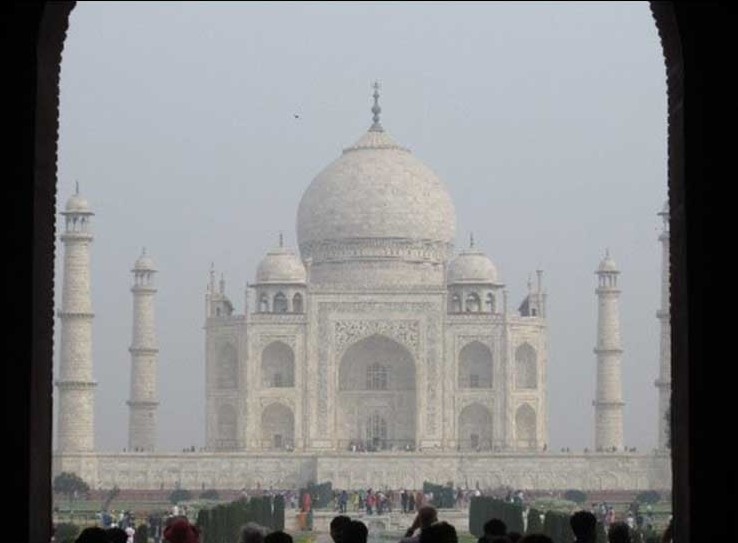
Though the aesthetic of a building, such as the Taj Mahal, is a classical measure of its elegance, the systems within it must contribute to its beauty. Environmental control is one such system that has evolved in the last century to normally require mechanization. Reynor Banham provides one of the best reviews of this advancement. In his analysis, Banham describes how this forced a symbiosis between the engineer and the architect to create elegant buildings. Great design happens when the architect sees the building as a system, and the engineer perceives systems as architecture.
Nevertheless, this elegance is derived from deliberate practice. It doesn’t just happen. To this end, Griffin identified four properties of elegance in system design :
- Efficacy — the achievement of the project goals.
- Robustness — the performance of the system under unanticipated circumstances.
- Efficiency — the least cost among competing alternatives.
- Consequences — accomplishing the goals with minimal unintended consequences.
These four properties can be used to define elegance in building systems, but they miss the ingredient discussed by Banham: integration. This is expressed as the cooperation among systems in the building. In an elegant design, the many systems collaborate in a manner appearing seamless and natural. Perhaps the failure to account for integration falls under unintended consequences. However, the engineer and architect know how the building systems will work together prior to construction. A failure in this respect cannot be an unintended consequence. Consider Figures 2A, 2B, and 3. Both design teams knew an air handler would be installed on the roof, and both buildings are prominent faces for their universities. In Figures 2a and 2b the air handler is placed on the roof in a manner minimizing its appearance from the ground and is clad in an attractive skin. It is nearly transparent from the ground. On the building in Figure 3, the rooftop equipment, as seen from a major highway, is a blight to its appearance. Although this building’s HVAC design may be efficacious, robust, efficient, and with few unforeseen consequences, because it is not integrated into the building’s architecture, the HVAC design is inelegant.

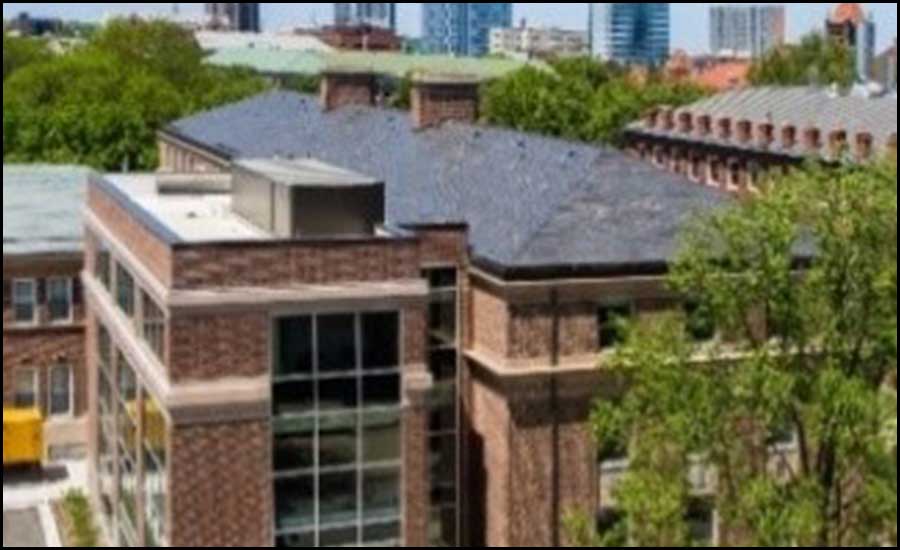
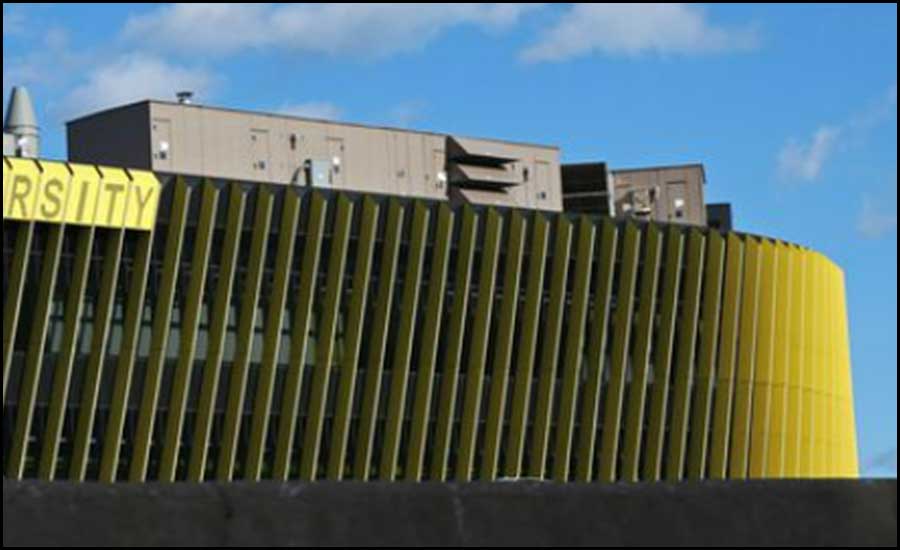
Optimizing the five properties starts with the BOD, which is always derived from the owner’s project requirements (OPR). Stum describes the relationship between the BOD and OPR and the formation of both. The OPR is the primary contributor to context for the project. By articulating how the system will be employed and what is expected, this context allows the system to be designed as a coherent idea. Without it, the system will not achieve elegance. Other factors influencing context are the legal requirements and standard-of-care required for the design. If the BOD has properly documented the project requirements by incorporating the OPR, legal requirements, and standard-of-care, the context for the project is understood, and the design has a good chance of finding elegance. In fact, the continued communication of the project’s context through the BOD may be the most important action the design team can take to achieve elegance.
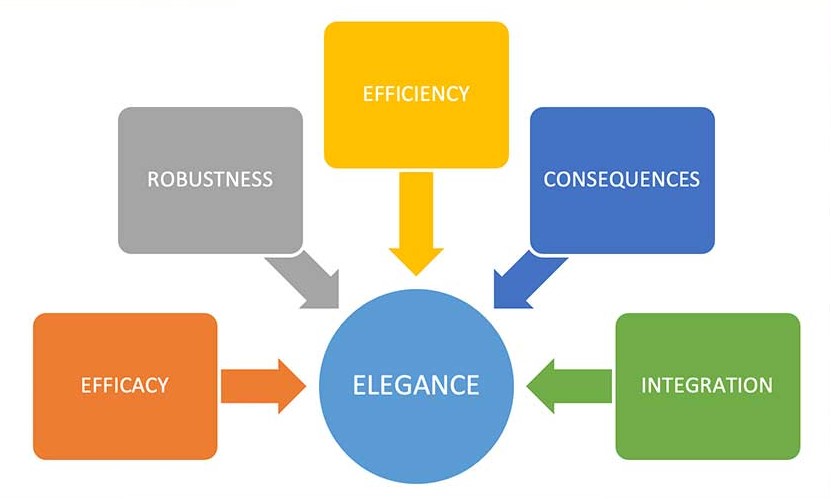
The BOD for an HVAC system includes many inputs but can be narrowed to the following steps:
- System sizing;
- System type/equipment selection;
- System layout; and
- System control.
To foster elegance in each of these steps requires diligence in applying the context for the project, the right tools to solve the tasks associated with each step and skill in using them, and cognizance of the elements of elegance while performing these tasks.
Sizing the system may seem unrelated to elegance, but the opposite is true. For example, context plays a significant role in how the loads are generated — the set points required by the OPR, the code requirements for energy use, and the standards governing the method of sizing. Further, the building’s architecture and its materiality influence heat transfer between the building and the environment. This perspective needs to be considered when sizing the system. Nevertheless, the most capable engineer cannot properly do this when handicapped by a lack of design tools. With respect to system sizing, this would include excellent thermal load-sizing programs and building energy modeling (BEM) software. In addition, building information modeling (BIM) can streamline communication between the disciplines on the project. With expert use of these tools, the system size can be optimized to positively impact the five elements of elegance. The impact of system sizing on elegance is seen in Figure 5.

A simple metric for system sizing is “less is more.” As the capacity of the system increases, the opportunities to optimize the properties of elegance diminish. This demonstrates the importance of the engineer and architect in working together to minimize the thermal loads. For instance, a high passive efficiency is accomplished by orienting the building on the site to reduce the solar loads and maximizing the thermal properties of the building envelope to lessen heat transfer. These measures can only be accomplished through extensive coordination between the various disciplines on the project. On the other hand, retrofit projects typically can’t apply these strategies, which is a challenging context for achieving elegance. Yet, even in renovation projects, the team can optimize the building’s thermal performance to minimize the size of the required HVAC systems.
Once the system size is understood, choosing the system is the next challenge. Several decisions must be made to recognize the most elegant system:
- Equipment location;
- Utilities;
- Method of air distribution; and
- Method of pipe distribution.
These evaluations have multiple answers, but one of them is the most advantageous in terms of elegance. Therefore, using the best method of selecting among the alternatives in relation to elegance offers the highest probability of choosing the most elegant system. A great tool for this is choosing by advantages (CBA). For example, the equipment may be located on the roof, at grade, or inside the building. Which is the most elegant approach? CBA provides a basis for ranking the decisions by comparing the advantages of each. Table 1 shows an example summary for equipment location. The properties of elegance are used as the factors, and the advantages of each option are ranked with context playing an essential role in their ranking. In this example, integration is deemed the most important factor. The resultant ranking shows locating the equipment inside as the obvious choice. This method can be applied for all decisions. The underlined advantages are the least attractive advantage under the factor. Table 2 shows potential alternatives for each decision. As decisions are made, the available alternatives for other decisions will be narrowed.
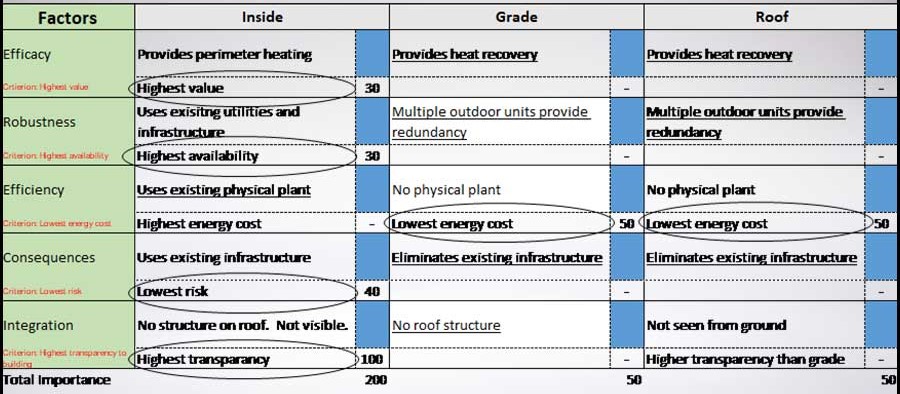
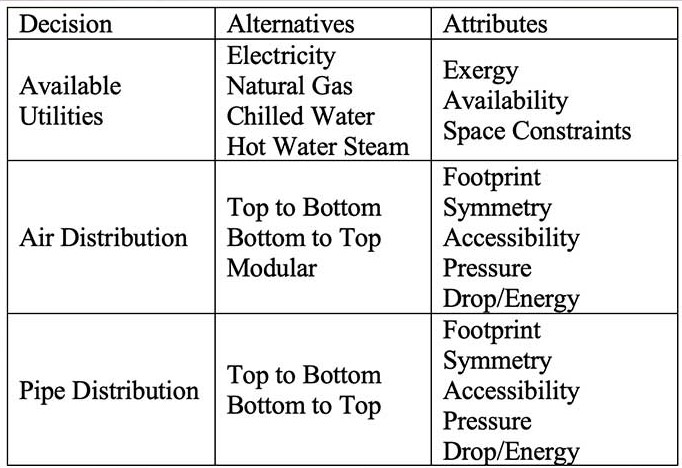
Once the most elegant equipment location, utilities, and air and pipe distribution methods are understood, the choice of the most elegant system will be obvious.
In the layout of the systems, context must be understood. A classic example is The Centre Pompidou in Paris in which the building mechanical systems are key elements of the building’s aesthetic. How many engineers have a chance to display their skill on such a grand scale?
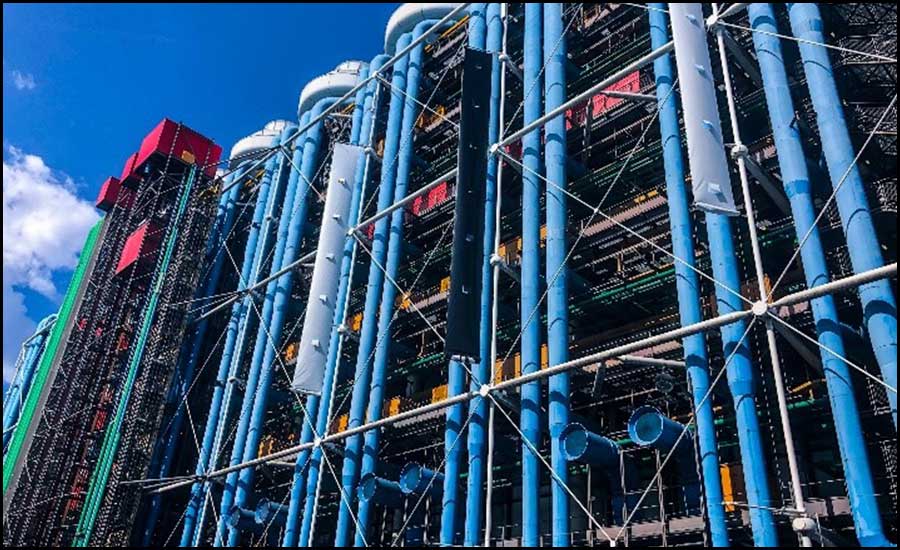
On the other hand, retrofit projects may require more subtle techniques. Though exposed in an alley, the condensing units serving interior spaces of the historic building in Brussels, as shown in Figure 7, are hidden from most eyes. Though there may be consequences, such as noise in the spaces near the condensers, this is likely the most elegant solution to conditioning the building.
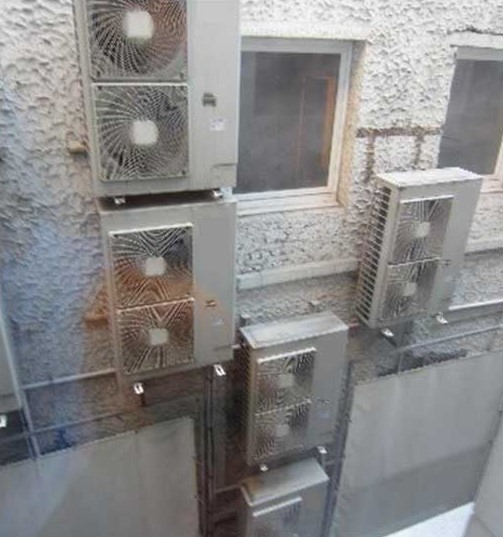
As in system sizing, “less is more” is a common theme in system layout. In the Pompidou Centre, the bends in duct and pipe appear to be kept to a minimum as well as their diameters and lengths. Excess would be very noticeable. Similarly, the condensing units in the historic building are likely the minimum number required at the minimum capacity needed. This observation correlates to Mathew May’s concept of subtraction as a means of achieving elegance. Subtraction is the art of removing excess from the design. When the properties of elegance are used as guideposts, subtraction always finds the graceful layout — a shorter path, a straighter route, or a simpler method. BIM enables subtraction by allowing the disciplines in the team to concurrently view the project and position systems in a complimentary manner to other assemblies in the building. Unfortunately, subtraction invariably requires design iterations, but this inefficiency in the process is offset by eliminating rework after design reviews and avoiding coordination issues during construction.
“Simplicity carried to an extreme, becomes elegance.” This quote from writer Jon Franklin epitomizes the quest for elegance in HVAC system control. Perhaps the best tool for achieving this is ASHRAE Guideline 36, “High-Performance Sequences of Operation for HVAC Systems.” This document represents the standard of care for specifying control sequences. Subtraction is another important technique used in the design of controls. Minimizing points and controlled elements lessens complexity and is vital to the performance of the control system. A method for facilitating subtraction is the analysis of the degrees of freedom in the process. The impact of the design of system control on elegance is presented in Figure 8.
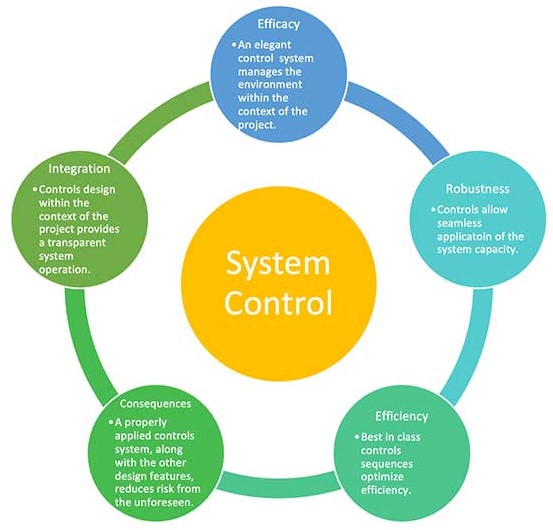
In an elegant building, everything works well. It effortlessly manages its functions and delights its occupants and guests. Its HVAC system is typically invisible to its occupants. It’s a system requiring minimal financial capital or physical effort to operate. This doesn’t happen by accident. Elegance results from mindfulness in applying the context for the project, using the right tools to solve the tasks associated with each step, and being cognizant of the properties of elegance while performing these tasks.
- Watson, Michael D., and Michael D. Griffin, “System Engineering: The Discipline of Engineering Elegance,” NASA internal paper, November 2013, https://www.nasa.gov/sites/default/files/atoms/files/system_engineering_discipline_22_nov_2013.docx
- Banham, Reyner, The Architecture of the Well-tempered Environment, Second Edition, The University of Chicago, 1984.
- Griffin, Michael D., “How Do We Fix System Engineering?”, 61st International Astronautical Congress, Prague, Czech Republic, 27 September – 1 October 2010, 1-9.
- Stum, Karl, Design Intent and Basis of Design: Clarification of Terms, Structure, and Use, ASHRAE Transactions, 2000, pp. 1181-1192.
- Varley, John, “Streamline the Modeling Process by Exporting Data Within BIM,” Engineered Systems, 37 (December 2020), 32-37.
- Varley, John, and Paz Arroyo, “Choosing by Advantages-Making Sound Decisions to Solve the Pandemic Readiness Puzzle”, Engineered Systems, 38 (October 2021), p.33.
- May, Matthew, In Pursuit of Elegance: Why the Best Ideas Have Something Missing, Doubleday, New York, NY, 2009.
- Franklin, Jonathon, 1986. Writing for Story: Craft Secrets of dramatic nonfiction Non-Fiction, Penguin Publishing Group, New York, N.Y. P. 72.
- ASHRAE, 2018. High-Performance Sequences of Operation for HVAC Systems, ANSI/ASHRAE Guideline 36- 2018.
- Varley, J.O., Degrees of Freedom in HVAC Controls Design, ASHRAE Journal, 57, (June 2015), 44-48.





